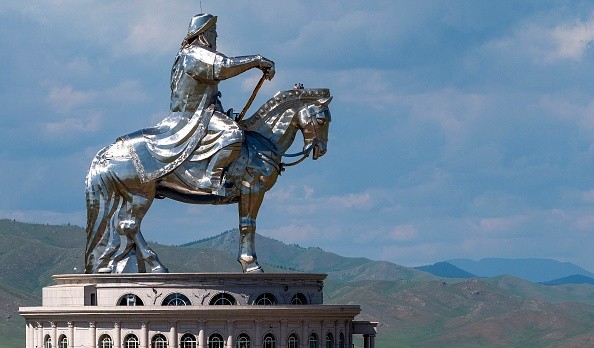In 1211, Genghis Khan pushed his army into the quasi-Chinese Chin-ruled north China, and in 1215, he destroyed the capital city.
Hisson Ogodei conquered and controlled all of North China from 1229 until 1241.
Meanwhile, Kublai Khan, Genghis Khan's grandson, destroyed the Chinese Southern Song in 1279, bringing all of China under foreign dominion for the first time.
Historians are fascinated by the expansion of herders and cattle into the eastern steppe, but few experts have linked the introduction of herds and horses to the formation of sophisticated cultures.
Social Changes In Ancient Mongolia
 (Photo : JOEL SAGET/AFP via Getty Images)
(Photo : JOEL SAGET/AFP via Getty Images)

Recent research published in the journal PLOS ONE offered multidisciplinary evidence for links between cattle dairying and the growth of social complexity in the eastern steppe.
The researchers showed a change in dairy intake throughout the Bronze Age by using proteomic analysis of human dental calculus from locations in Mongolia's Altai.
Researchers discovered the essential importance of domesticated sheep, goats, and cattle in ancient civilizations by analyzing dairy intake among communities in Mongolia's the Altai Mountains.
The introduction of ruminant livestock resulted in increased population, the creation of communal cemeteries, and the erection of massive monuments.
While these dramatic changes coincided with the first evidence of horse dairying in Mongolia, horse dairy eating remained a relatively new activity until later eras.
According to research lead author Alicia Ventresca Miller, assistant professor of anthropology at the University of Michigan, the migration of herds into the Mongolian Altai resulted in rapid alterations to human diets, with a delay in future social and demographic developments, as per ScienceDaily.
Ventresca Miller and colleagues from the University of Michigan and Germany's Max Planck Institute for the Science of Human History isolated proteins from calculus samples in order to find caseins and whey linked with ruminant and horse dairy.
The findings were evaluated in collaboration with experts from the National University of Mongolia and the National Museum of Mongolia in order to better understand how ancient cultures altered following the adoption of domesticated animals.
According to Ventresca Miller, long-term reliance on sheep, goats, and cattle spurred dramatic societal transformations and enormous buildings.
This is reinforced by the discovery of primarily ruminant bones in massive monumental Khirgisuurs in the Altai Mountains, as well as horse bone deposits in other locations of Mongolia.
Also Read: Dust Storm Strikes Mongolia; Forecast of Strong Winds and Heavy Snow in the Coming Days
Mongol dynasty
Kublai Khan called his dynasty Yuan, which means "beginning of the cosmos," in 1271, and it ruled China from 1279 until 1368.
Kublai Khan pursued a tentative program of Sinicization, in which he assimilated to the Chinese method of government, and his image resembled previous Chinese monarchs.
On the other hand, although using some Chinese in low-level government jobs, he eliminated civil service examinations, preferred to utilize Chinese in his bureaucracy, and established different regulations for Mongols and Chinese.
His capital, modern-day Beijing, grew into a cosmopolitan and prosperous metropolis, as per Asia Society.
Kublai Khan desired to help agriculture, thus he established the Office for Agriculture Stimulation.
Although many of his subjects want to maintain the herding lifestyle within the walls, in 1262 he issued an order preventing nomads' animals from straying on farmland.
He stocked food storage places in preparation for future famines, particularly in the north, where fields had been destroyed by incessant conflict.
The capital contained 58 granaries that held 145,000 shih (one shih equaled 133 lbs).
Marco Polo claimed to have fed 30,000 destitute people in the capital every day. He divided the farmers into she groups. Each lady was made up of 50 families.
They were encouraged to participate in self-help programs like as tree planting, irrigation and flood control, stocking rivers and lakes with fish, and increasing silk manufacture.
They were to monitor their own members, rewarding those who worked hard and punishing those who were sluggish.
She also assisted the censor in keeping an eye on the attendees. It emphasized basic literacy and instruction in improved farming practices.
Related article: Heatwaves in Inner East Asia Including Mongolia are Causing Irreversibly Drier and Hotter Conditions of Climate
© 2024 NatureWorldNews.com All rights reserved. Do not reproduce without permission.

![Tsunami Hazard Zones: New US Map Shows Places at Risk of Flooding and Tsunamis Amid Rising Sea Levels [NOAA]](https://1471793142.rsc.cdn77.org/data/thumbs/full/70325/280/157/50/40/tsunami-hazard-zones-new-us-map-shows-places-at-risk-of-flooding-and-tsunamis-amid-rising-sea-levels-noaa.jpg)



